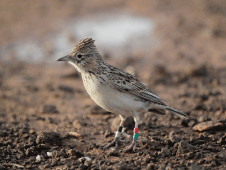
Raso Lark Alauda razae was until recently found only on the small island of Raso in Cape Verde. The already small population of this bird is subject to extreme fluctuations according to rainfall, putting it at high risk of extinction. Sub-fossil evidence suggests that the species historically occurred on the nearby island of Santa Luzia, so re-introduction of the species to this island was identified as a viable conservation strategy. Following a cat eradication programme on Santa Luzia, translocations of larks were carried out in 2018 and 2019, and, despite the COVID-19 pandemic putting a halt to work during much of 2020, initial results are promising. During the latest trip to the island at least 50 birds and 9 nests were recorded, and there were no signs of feral cats.
Until recently, Raso Lark Alauda razae occurred only on the small uninhabited islet of Raso, Cape Verde. This small brown lark inhabits level plains with volcanic soil, favouring small patches of vegetation along dry stream beds where it forages for seeds and invertebrates. Breeding occurs following rainfall; therefore, long periods of drought are associated with reduced breeding activity, resulting in significant fluctuations in population size. During 2004 to 2019, the population size of this species fluctuated from a low of 57 to a high of 1,550 individuals (Brooke 2019, cited in Brooke et al. 2020). The extremely small range of the species, combined with the extreme fluctuations in population size, means that it is classified by BirdLife International as Critically Endangered on the IUCN Red List of Threatened Species.
Evidence from sub-fossil bone deposits suggests that the species historically occurred on the nearby islands of Santa Luzia, São Vicente and Santo Antão before humans colonised them in the 15th century (Mateo et al. 2009). In 2004, it was suggested that a re-introduction of Raso Lark to Santa Luzia may help to boost the population, and in 2011 a grant was awarded by the MAVA Foundation to SPEA (Sociedade Portuguesa para o Estudo das Aves, the BirdLife Partner in Portugal) enabling work to start on the translocation. Although Santa Luzia is not currently inhabited by humans, it has been in the past and as a result is occupied by non-native cats and mice. The effect of cats on Raso Lark populations is not known, but as ground-nesting birds they are likely to be extremely vulnerable to predation by invasive mammals. Therefore a cat eradication programme was initiated before reintroductions began.
The first translocations were carried out in April 2018. A total of 37 birds (25 males, 12 females) were captured on Raso and transported by boat to Santa Luzia, where they were released (Brooke et al. 2020). The first 12 birds to be released were radio tagged to allow their post-release movements to be monitored, however subsequent birds were not tagged due to concerns over increased predation by Common Kestrel Falco tinnunculus of tagged birds. Observations made throughout the rest of 2018 indicated a steady decline in the number of larks on Santa Luzia, but the first evidence of successful breeding – a young fledgling – was seen in July.
At the start of 2019, at least 12 Raso Larks remained on Santa Luzia. The small size of this population made it vulnerable to extinction, therefore a second translocation was carried out in March 2019 (Brooke et al. 2020). This time 33 birds (19 males, 14 females) were captured and transported to Santa Luzia, where they were released in areas frequented by the larks already living on the island. In October 2019, the minimum Santa Luzia population was 40-50 individuals. Surprisingly, natural movement of birds between Raso and Santa Luzia was also observed, suggesting that birds may have been visiting Santa Luzia for years, but only recently stayed long enough to be sighted. This may be due to increased survival following the removal of the cat population, or due to the translocated birds providing a social attraction to immigrants.
The COVID-19 pandemic led to the evacuation of all project personnel from Santa Luzia in March 2020, delaying eradication of the last few cats on the island and interrupting monitoring of the lark population. However, during the latest visit to the island at least 50 birds and 9 nests were recorded, and a male chick ringed in November 2020 was found breeding in February 2021, suggesting that progress to maturity on the island is quick (SPEA 2021). There were also no signs of feral cats. It is still early days for this project; however, initial results are promising. Regular monitoring and ongoing control of introduced mammals will be necessary to ensure that the reintroduced population remains viable and continues to grow.
Related Case Studies in other sections
Related Sites
Related Species
Links
SPEA Santa Luzia restoration project website
References
Brooke, M., Gregory, L., Geraldes, P., Castelló, L., Donald, P. F., Melo, T. & Bores, J. (2020) Lessons and surprises from an inter-island re-introduction of the Critically Endangered Raso Lark Alauda razae of Cape Verde. PARKS, 26(2):47-58
Mateo, J.A., López Jurado, L.F. and Geniez, P. (2009). Historical distribution of the Raso Lark Alauda razae in the Cape Verdes. Alauda, 77:309–312.
SPEA (2021) Raso Lark surpasses expectations. SPEA, 6 April 2021. Available at: https://www.spea.pt/en/raso-lark-surpasses-expectations/
Compiled: 2022 Last updated: 2022
Recommended Citation:
BirdLife International (2022)
Raso Lark has been successfully re-introduced to the island of Santa Luzia.
Downloaded from https://datazone.birdlife.org/sowb/casestudy/raso-lark-has-been-successfully-re-introduced-to-the-island-of-santa-luzia on 22/12/2024